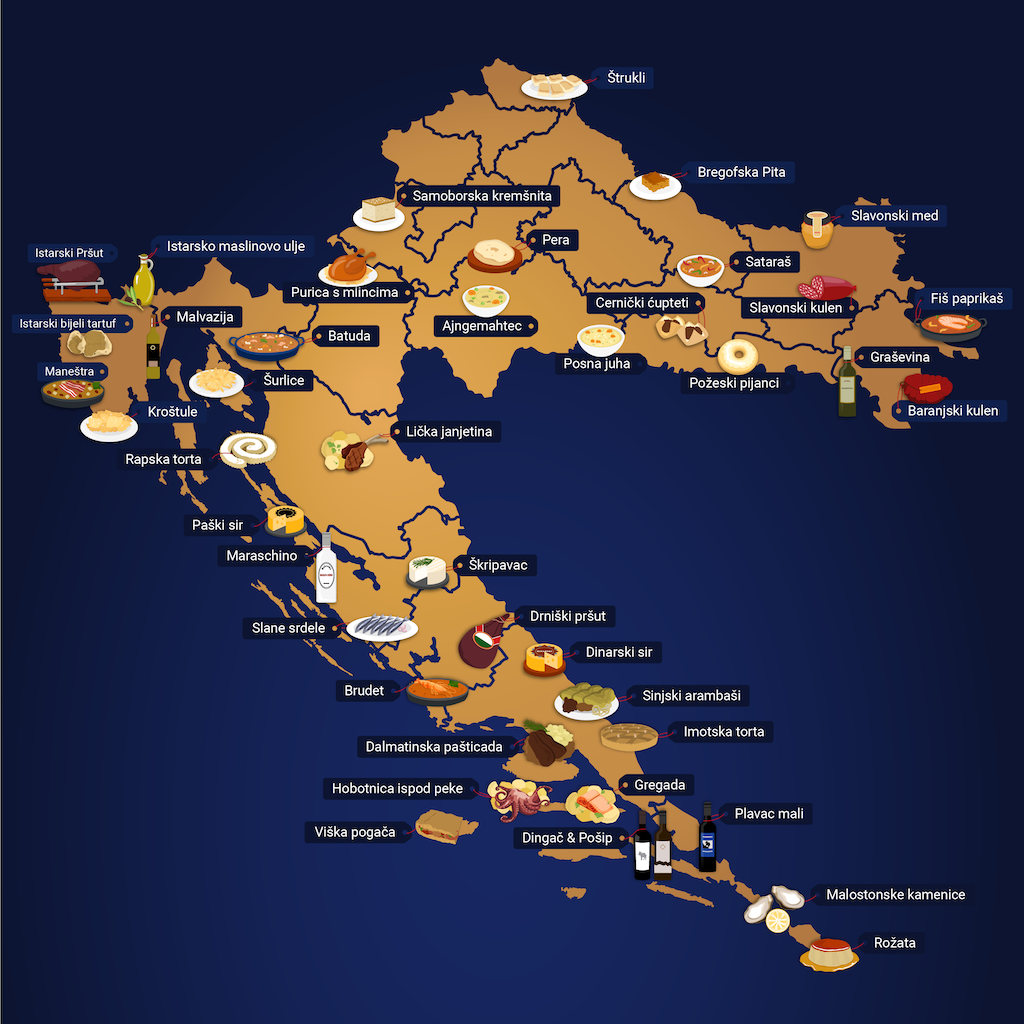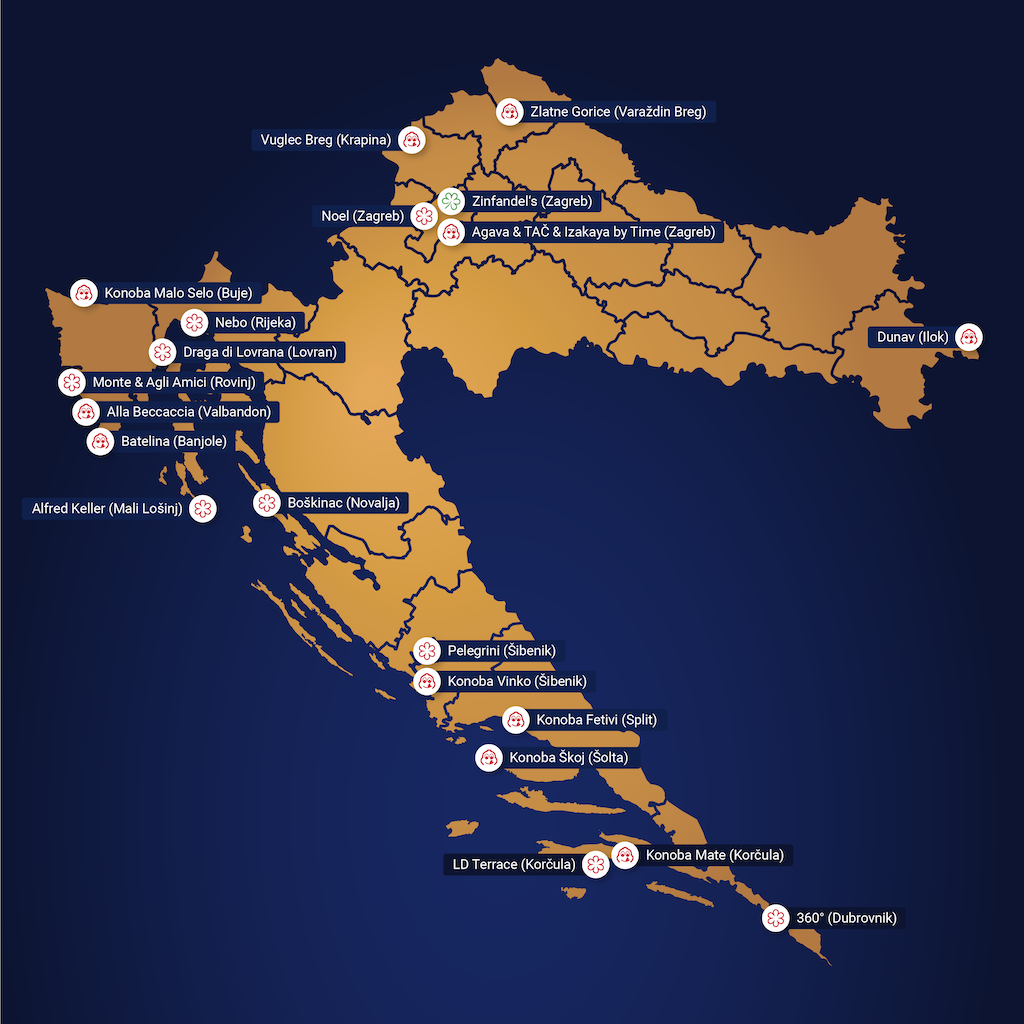Flavors of Croatia: From Local Specialties to Michelin-Starred Restaurants
November 24, 2021 - What can be said about Croatian cuisine? Are the old clichés still true? Are Croatians still carnivores who eat everything with bread? A look at the flavors of Croatia, from local specialties to Michelin-starred restaurants.
As Croatia Luxury Rent reports, Croatia has a heterogeneous and regional cuisine in which each part of the country has its own culinary tradition. And given Croatian history, the regional cuisines often resemble the styles of other countries, some of which have long since ceased to exist.
The influence of antiquity, Illyrians, Mediterranean cuisine, and Italian, French, Viennese, and Hungarian can be felt on the Adriatic. Austro-Hungarian cuisine sends greetings from continental Croatia, as does Turkish.
While you'll find mostly fish, seafood, fruits, vegetables, and olive oil on the coast and islands, in continental Croatia, you'll find more meat, grains, fruits, vegetables, eggs, and dairy products - and the preparation methods are more complex and dishes more nutritious. Both cases boast seasonal cuisine.
Croatian regional cuisines are divided into Istria, Dalmatia, Dubrovnik, Lika, Zagorje, Međimurje, Podravina and Slavonia. Each region has its own specialties, which are not always so well known to everyone at the national level.
So, what is the DNA of a Croatian kitchen? What are Croatian specialties? What makes them unique? Who are the pioneers of Croatian gastronomy? What is the future of Croatian cuisine? Which restaurants are especially worth visiting?
To that end, Croatia Luxury Rent spoke with industry leaders and restaurants.
Despite all the influences, there are many Croatian specialties that you will not find anywhere else except in Croatian regions, and there are also dishes you may not have heard about!

Sinj arambaši: Arambaši - a traditional dish from the Croatian town of Sinj - is an unusual variant of sarma and consists of a combination of minced beef, onion, garlic, pork belly, and parsley. The mix is usually seasoned with pepper, salt, cloves, cinnamon, nutmeg, and grated lemon zest.
This mixture is then wrapped in sauerkraut leaves and placed in a pot. Before cooking, arambaši is covered with chopped sauerkraut, beef bones, tomato juice, water, and various dried meat products. The dish's name comes from the Turkish words 'harami', which means sinful or unacceptable, and 'başi,' which implies commander or chief. It is traditionally served at festivities such as Easter or Christmas, but arambaši are especially popular during the Feast of the Assumption and the popular Sinjska Alka.
Požeski pijanci: Pijanaci is a traditional cake originating from the town of Požega. The cake is made of flour, eggs, yolk, lard, and sugar. The dough is cut into pieces that are shaped into coils with a hole in the middle.
After baking, the tops are dipped in egg whites and sugar and then dry in the oven.
In the past, pijanci were traditionally consumed in the afternoon while drinking wine with friends and neighbors, and the cakes were soaked in wine, hence the name!
Šurlice sa škampima: This specialty originates from the Croatian island of Krk. It consists of a local variety of pasta known as šurlice, combined with onion, garlic, shrimp, tomato juice, white wine, and stock. The pasta is sometimes sautéed in butter before being combined with the other ingredients. It is recommended to supplement the dish with grated cheese before serving.
Learn more about how experts or the kings and queens of Croatian specialties see their products and work, and what makes Croatian cuisine so unique HERE.
Croatian restaurants are impressive, as well. Not only did Croatia receive three new Michelin-starred restaurants last year, but the country also has several Bib Gourmand restaurants and one Michelin Green Star restaurant for exceptional sustainability.

1 Michelin star:
- 360⁰, Dubrovnik
- Draga di Lovrana, Lovran
- Monte, Rovinj
- Pelegrini, Šibenik
- Noel, Zagreb
- Boškinac, Novalja
- LD Terrace, Korčula
- Agli Amici, Rovinj
- Alfred Keller, Mali Lošinj
- Nebo, Rijeka
Bib Gourmand:
- Batelina, Banjole
- Dunav, Ilok
- Konoba Mate, Korčula
- Vuglec Breg, Krapina
- Konoba Vinko, šibenik
- Konoba Fetivi, Split
- Agava, Zagreb
- TAČ, Zagreb
- Konoba škoj, šolta
- Zlatne Gorice, Varaždin Breg
- Izakaya by Time, Zagreb
- Konoba Malo Selo, Buje
- Alla Beccaccia, Valbandon
Michelin Green Star:
- Zinfandel's, Zagreb
You can read more about Croatia's haute cuisine in an interview with LD Restaurant's Marko Gaski HERE.
For more, make sure to check out our dedicated lifestyle section.
Croatia Luxury Rent Study Reveals European Travel Behavior in 2021
April 16, 2021 - Croatia Luxury Rent, an agency that offers luxury vacations in beautiful villas all along the Croatian coast, has conducted a study about European travel behavior this season.
A study by Croatia Luxury Rent (CLR) reveals that Croats and most Europeans are ready to travel again, whether it be in their own country or abroad. The good news for Croatia is that it is trusted as a safe destination, with vaccinations on the rise, and many remote locations and exclusive accommodations to book outside of all-inclusive hotels.
Based on booking figures and Google Trends search statistics, CLR was able to evaluate European travel behavior for the upcoming season.
Namely, Croats currently make up 1 percent of CLR reservations, which could be thanks to the relatively small Croatian population, privately owned holiday homes, a more spontaneous mentality when it comes to travel, and that vaccination has only just begun.
Interestingly, more than a third of CLR's bookings come from German guests (39 percent), followed by Austrians (17 percent) and 11 percent from the UK. This could be a consequence of both early vaccination programs and those hoping to travel to the sun and the sea, as snow and viruses rage elsewhere.
Eight percent of CLR's reservations are from Scandinavia, and 5 percent from Swiss and French guests.
Although the number seems relatively small, demand for holiday homes and villas has increased in recent months.
"I think we are in a better situation this summer than last year. We know what COVID-19 is and how to behave in a pandemic situation. Vaccination has also just begun. I expect the tourist season to be between the last and record 2019 summer. Croatia will follow the guidelines of the "Stay Safe in Croatia" initiative, which will guarantee guests the safe implementation of all epidemiological regulations. In addition, vaccinations of employees in the tourism sector are planned before the main season," said Veljko Ostojic, former Minister of Tourism and current director of the Croatian Tourism Association.
"Based on the reservations we received in the new year, we can say that the Croatian people want to return to 'normal' life. While tourism stagnated last year due to planning difficulties and many countries blocked, there is new hope this year thanks to vaccination. Countries like Croatia are better prepared now - they know what they are dealing with and how to safely deal with anti-virus regulations. Of course, this could not be possible without the cooperation of tourists, who can't wait to have a nice holiday again," said Tomislav Fain, President of the Association of Croatian Travel Agencies.
You can find the full study on CLR HERE.
For more on travel in Croatia, follow TCN's dedicated page.
Croatia Luxury Rent Reveals Secret of Success During Pandemic
As Poslovni Dnevnik/Marija Crnjak writes on the 6th of November, 2020, one travel agency, Croatia Luxury Rent, specialising in the placement of luxury private accommodation, achieved an impressive 12 percent increase in arrivals when compared to the summer period last year throughout the period from the end of May to the end of August this year.
With an average occupancy rate of as much as 86 percent even in spite of the pandemic is to be applauded. The founder of Croatia Luxury Rent, Josip Stulic, has offers along the entire Croatian coast.
The best results were achieved by the counties of Istria and Primorje-Gorski Kotar, followed by the counties of Zadar and Split-Dalmatia. The weakest results were recorded in the counties from the extreme south of Dalmatia, which can easily be explained by the significant traffic distance for visitors arriving by car, and the disruption of air traffic we've seen this year.
The fact that after the end of the spring lockdown, most of the emitting markets rated Croatia as a safe destination is responsible for the overall positive result. Stulic emphasised that he expects Croatia to have a reputation as a safe destination next year as well.
"The largest numbers of booking requests were related to the safety of accommodation, a kind of isolation from major tourist areas and accommodation facilities that allow a sense of residence in the units, such as swimming pools, jacuzzis, outdoor fireplaces, and multimedia," explained Stulic.
Of the total number of Croatia Luxury Rent's guests, the Germans made up 26 percent, 11 percent of the agency's visitors came from the Benelux countries, 10 percent were Scandinavians, 9 percent were Austrians, 6 percent were Slovenes and the same number was made up by the Swiss, and finally - 5 percent were Hungarians and Poles.
"Our predictions are that Croatian tourism and the next tourist season will be attractive to guests primarily from Europe, and we expect that Croatia will be one of the tourist leaders in the Mediterranean in 2021,'' said Stulic.
For the latest travel info, bookmark our main travel info article, which is updated daily.
Read the Croatian Travel Update in your language - now available in 24 languages




